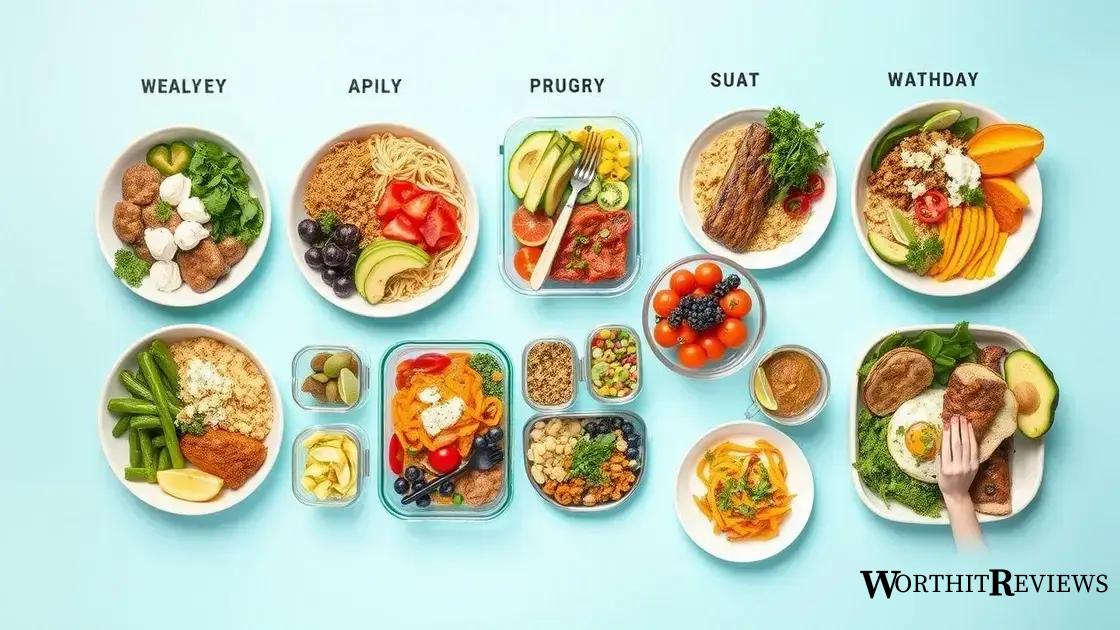Healthy eating menus for weight loss prioritize whole foods, balanced macronutrients, and mindful eating habits while incorporating variety and meal prepping strategies for sustainable and enjoyable weight management.
Are you ready to explore healthy eating menus for weight loss? Finding that perfect balance between nutrition and enjoyment can feel daunting. Let’s dive into how you can craft menus that nourish your body and delight your taste buds.
Understanding the principles of healthy eating for weight loss
Understanding the principles of healthy eating for weight loss goes beyond simply cutting calories. It’s about nourishing your body with the right foods to support your overall health and well-being while achieving sustainable weight management. Let’s break down the key components:
Calorie Balance:
Weight loss ultimately comes down to consuming fewer calories than you expend. However, drastically cutting calories can lead to nutrient deficiencies and rebound weight gain. Focus on creating a moderate calorie deficit through balanced food choices and portion control.
Macronutrient Ratio:
Macronutrients—protein, carbohydrates, and fats—play crucial roles in a healthy eating plan. Protein helps you feel full and maintain muscle mass during weight loss. Choose lean sources like chicken, fish, beans, and lentils. Carbohydrates provide energy. Prioritize complex carbohydrates like whole grains, fruits, and vegetables over refined carbs like white bread and sugary drinks. Healthy fats are essential for hormone production and nutrient absorption. Include sources like avocados, nuts, seeds, and olive oil.
Micronutrients:
Vitamins and minerals are vital for optimal bodily functions. A balanced diet rich in fruits, vegetables, and whole grains usually provides adequate micronutrients. Consider a multivitamin if you have specific dietary restrictions or concerns.
Hydration:
Water plays a critical role in weight management. It helps you feel full, supports metabolic processes, and can even temporarily boost metabolism. Aim to drink plenty of water throughout the day.
Mindful Eating:
Pay attention to your body’s hunger and fullness cues. Avoid distractions while eating and savor your meals. This helps prevent overeating and promotes a healthier relationship with food.
Creating balanced menus that satisfy your cravings

Creating balanced menus that satisfy your cravings is key to successful weight loss. It’s not about deprivation; it’s about making smart food choices that nourish your body and keep you feeling satisfied. Here’s how to build menus that work:
Prioritize Whole Foods:
Build your meals around whole, unprocessed foods like fruits, vegetables, lean proteins, and whole grains. These foods are packed with nutrients and fiber, helping you feel full and energized.
Consider Your Cravings:
Don’t ignore your cravings! If you’re craving something sweet, opt for a piece of fruit or a small square of dark chocolate. If you’re craving something salty, try air-popped popcorn or roasted chickpeas.
Plan Your Meals:
Planning your meals ahead of time can prevent impulsive food choices. Take some time each week to map out your breakfasts, lunches, and dinners. This will help you stay on track and make healthy choices.
Don’t Forget Snacks:
Healthy snacks can help keep you satisfied between meals and prevent overeating. Pack snacks like nuts, seeds, fruits, or vegetables to keep on hand.
Experiment with Flavors:
Healthy eating doesn’t have to be bland. Experiment with different herbs, spices, and seasonings to add flavor and excitement to your meals. Explore different cuisines and cooking methods to keep things interesting.
Example Menu:
- Breakfast: Oatmeal with berries and nuts
- Lunch: Salad with grilled chicken or fish
- Dinner: Salmon with roasted vegetables
- Snacks: Apple slices with almond butter, Greek yogurt with fruit
Tips for meal prepping healthy eating menus
Meal prepping is a game-changer for healthy eating and weight loss. It saves time, reduces stress, and helps you stay on track with your dietary goals. Here are some effective tips for meal prepping healthy eating menus:
Plan Your Meals:
Before you head to the grocery store, create a meal plan for the week. This ensures you buy only what you need and helps you stay organized.
Batch Cook Staples:
Cook large batches of grains (like quinoa or brown rice), proteins (like grilled chicken or baked tofu), and roasted vegetables. These can be mixed and matched throughout the week for various meals.
Invest in Quality Containers:
Good quality, airtight containers are essential for storing prepped meals. Look for containers that are freezer, microwave, and dishwasher safe.
Portion Out Meals:
Divide your prepped meals into individual portions to control calorie intake and make grab-and-go meals easier.
Prep Smart Snacks:
Don’t forget about snacks! Pre-portion nuts, seeds, fruits, and vegetables for easy and healthy snacking options.
Utilize Your Freezer:
The freezer is your friend! Freeze prepped meals or individual ingredients like cooked grains or sauces for longer-term storage.
Get Creative with Leftovers:
Transform leftovers into new meals to avoid food waste and add variety to your diet. Roasted chicken can become chicken salad or soup, while roasted vegetables can be added to omelets or frittatas.
Make it a Routine:
Set aside a specific time each week for meal prepping. Sunday afternoons often work well, allowing you to start the week with a fridge full of healthy meals.
Incorporating variety to keep your diet interesting

Variety is the spice of life, and it’s crucial for maintaining a healthy and enjoyable weight loss journey. Eating the same foods repeatedly can lead to boredom and increase the temptation to stray from your healthy eating plan. Here’s how to incorporate variety:
Explore Different Cuisines:
Venture beyond your usual recipes and explore different cuisines. Each cuisine offers unique flavors and ingredients, keeping your taste buds excited.
Seasonal Produce:
Take advantage of seasonal fruits and vegetables. They’re not only fresher and tastier but also offer a wider range of nutrients.
Try New Cooking Methods:
Experiment with different cooking methods like grilling, roasting, stir-frying, and steaming to add variety to your meals.
Spice it Up:
Herbs, spices, and seasonings can transform a simple dish into a culinary masterpiece. Don’t be afraid to experiment with different flavor combinations.
Themed Meal Nights:
Designate specific nights for different types of meals, like “Meatless Monday” or “Taco Tuesday.” This adds structure and excitement to your weekly menu.
Don’t Be Afraid to Experiment:
Try new recipes and ingredients regularly. You might discover new favorites that fit perfectly into your healthy eating plan.
Focus on Colorful Plates:
A visually appealing plate is often a more enjoyable one. Aim for a variety of colors from different fruits and vegetables to make your meals more enticing.
Creating healthy eating menus for weight loss is a journey, not a destination. By understanding the principles of healthy eating, creating balanced meals, mastering meal prepping, and embracing variety, you can achieve sustainable weight loss while enjoying delicious and satisfying food. Remember that consistency and a positive mindset are key to long-term success. Don’t be afraid to experiment, find what works best for you, and enjoy the process of nourishing your body and achieving your weight loss goals.
